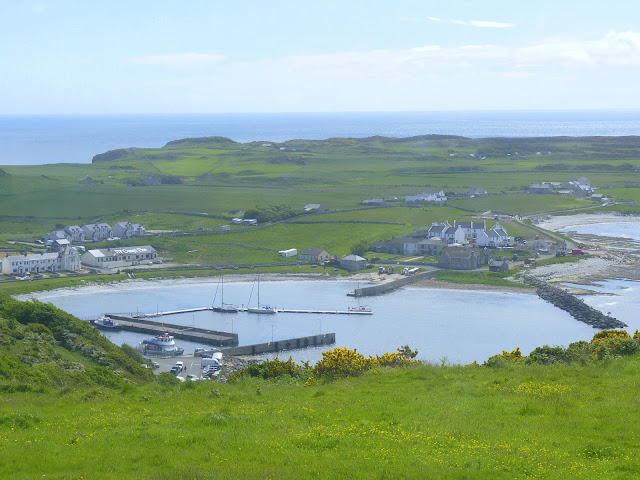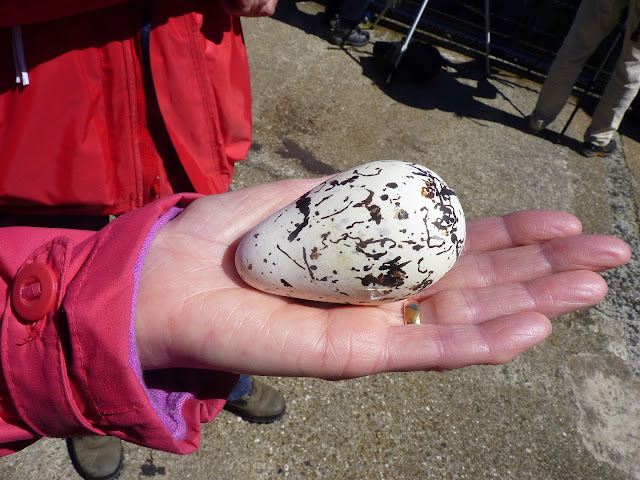Fulmar, Kittiwake, Razorbill, Common Guillemot and Puffin.
Before I show you these, here are some photos taken either from the bus or when we arrived above the 'Stacks'.

As you have seen from the video yesterday, the cliffs are very high as as such the birds are better seen through a telescope however I have done my best with my limited camera ability.
Fulmar
Because you are standing high up and looking down, you can easy see the Fulmars with their very stiff wings, twist and turn as they fly about. The birds love to hang around in the wind along the cliff edges. However they also need the air’s turbulence to take off and land on nest ledges and these are jealously guarded. They mate for life and males return to nesting sites around Christmas to await the arrival of their partner. Ledges area important for another reason, they mate at the nest site as they cannot do so at sea.
 |
| Fulmar |
Kittiwake
I am sure you saw on yesterday’s video that Kittiwakes are
capable of nesting on vertical cliff faces and this means security for them,
their eggs and chicks. They cement
together wetted mud into irregularities and providing they make a good job of
it, the nest stayed attached. The lay
2-3 eggs and when hatched they have to stay still because of this precarious
nest. However they have a quiet
temperament and take food by placing their heads deep inside their parents’
mouths.
Kittiwake
Razorbill
They nest in isolation to avoid predation from gulls and
prefer an overhang or cervices. They
carry fish crosswise and usually give their chicks several fish at a time. As you can see from the egg below, it has a more pointed at one end (same as C. Guillemots) and therefore it is less likely to fall off the cliff when it rolls.
Razorbill Egg
Common Guillemot
As you can see from yesterday’s video and some of these
stills, Guillemots opt for safety in numbers and sometimes they are so close
they are touching their neighbours. They
have a single egg and stand awkwardly while incubating it but it is never in
sight. At present no chicks are born to
any of these birds. The parents only
feed chick one fish at a time and it is carried lengthwise. I might return to Rathlin later to see if I
can get any photos of the chicks although they try to keep them well
hidden. These little chicks are really
very brave because when the time comes to leave the nest, although they cannot
fly, they throw themselves off the cliff and hopefully don’t hit rocks but land
in the sea. They dive immediately so the
gulls don’t pick them off and the male will accompany them for several more weeks.
Common Guillemot Egg
Puffin
The Puffins on Rathlin were not as easy to see due to the
distance as they make their burrows at the bottom of a cliff and safe away from
predators. They use both their legs and
bill to excavate the burrow and laid 1 egg which take 6 weeks to hatch. When ready to leave the nest, they do so at
night and unlike the other auks, they have fully developed wings and therefore
can fly quickly away.


I hope you enjoyed this post. Thanking you for visiting and hope you will tune in tomorrow for the next episode!
In case my replies from yesterday disappear again, I would like to thank you all for your comments. I appreciate every one.
Oops! Have just discovered that when I got Lynn's comment for my post yesterday, my reply to you ALL HAD disappeared. This is what it said!
Hi This is my last try to reply to all of the above bloggers. To. Eileen, Carole
(thanks for alerting me about the video), Frank, Tex, Keith, CT, Bob, Saun,
Bailey, Ginny and Marcia, and Lynn many thanks for all you comments. I know from
them that you enjoyed this first post about Rathlin Island and I hope you all
will enjoy the rest of the posts. Margaret
















What an incredible place, it's so beautiful!
ReplyDeleteHi Gunilla Yes it is absolutely wonderful. Somewhere everyone should see. Thans for comments. Margaret
ReplyDeleteNot only are these pictures amazing but all the info is so interesting. I guess I could find the same in field guides but it is always better when given via someone personally.
ReplyDeleteThe third picture is beautiful! I have never heard of Fulmars, but your picture of the two of them is very sweet! How on earth did you get the egg? Your Puffin portraits are gorgeous!!!
ReplyDeleteHi Ruth I am so pleased that you have enjoyed not only the birds but also the information. I suppose it is the teacher in me!!! Of course I am sure there are a lot of peplle who know all this stuff however it is perhaps always good to be reminded of it, 'at our age!!!'Thanks for your kind comments. Maragret
DeleteHi Ginny
DeleteThank you for your kind comments. The 1st and 2nd photos were taken through the 'not so clean' bus window! The eggs were at the 'stacks' and had been collected by the RSPB volunteers and kept for people to see. As I knew I would be writing this up, I thought it would be a good idea to photograph them as I knew bloggers would want to see them. Hope you are keeping a bit better now and have had a good weekend.
Margaret
What a fabulous place, sea bird heaven! Amazing egg I loved the markings, and the puffin was lovely, I have a soft spot for them so it was really nice to see the photo. CT :-)
ReplyDeletethose colonies of nest birds are amazing! very cool.
ReplyDeleteas for replies to comments, blogger doesn't deliver them to us, so unless we go back to revisit your former post, we'll never see what you wrote. most of us just view the latest post and continue through our reading lists, so i'm guessing most folks don't see your replies anyway! :)
Great post again Margaret, and very informative.
ReplyDeleteSeems blogger has got the gremlins again.
Wow, the scenery is gorgeous. I love the view of the cliffs and seabird colonies. They remind of the seabird colonies in Oregon. The puffins are my favorite, they are so darn cute! Great post and I enjoyed your photos.
ReplyDeleteThose Puffin shots are sweet Margaret, it looks a great place.
ReplyDeletepeter
Super views of the local breeders Margaret.
ReplyDeleteRe: Comments and replies ..
I beg to differ with TexWisGirl as I have a very recent example of a two way conversation with a reader but I think it only works if both parties click the 'subscribe by email' and then you see everything in your gmail in box as well as in the comment section of the relative post.
what a wonderful site to visit Margaret; I would've loved that excursion! Beautiful scenery and wonderful sea-birds. The eggs are quite large..and I especially love the puffins
ReplyDeleteThis is super, you are so lucky to live so close and have the opportunity to see so many birds and know so much about each one. I just love visiting here!
ReplyDeleteWow! I have never seen a puffin close up! These are fantastic shots!
ReplyDeleteHow were you able to get those eggs? And, great close-ups of the puffins!
ReplyDelete